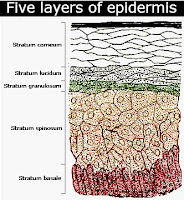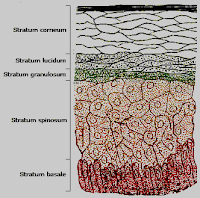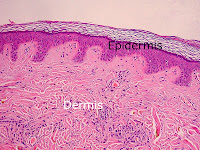Morphogenesis of epidermal keratinocytes
The keratinocytes originate from human epidermal stem cells present in the stratum germinativum (basal layer of epidermis). The progeny of these stem cells are termed transit amplifying (TA) cells. TA cells also reside in the basal layer and undergo mitosis. After a few rounds of mitosis, they undergo differentiation and move outwards. As they move outward, keratinocytes undergo a series of biochemical and morphological changes and pass through various layer-stages. Finally they die and turn into the outermost layer of dead cornecytes (stratum corneum) to be sloughed off.Structure and function of human keratinocytes
In the basal layer, Keratinocytes are cuboidal or columnar in appearance and are under continuous mitosis. They are separated from dermis by basement membrane and are attached to it through hemidesmosomes. Their function is to continuously divide and proliferate to maintain a regular supply of cells for differentiation in the upper layers.As the Keratinocytes move upwards into spinosum layer of epidermis, the process of mitosis ceases in them and they undergo keratinization. The nuclei of these cells function actively to synthesize cytokeratin. The cytokeratin, which is a type of fibrillar protein builds up within the keratinocytes and aggregate together to form tonofibrils. Then the tonofibrils form desmosomes. These desmosomes radiate from the keratinocytes and form points of connection between these prickle cells. The net-like structure of these prickle cells provides protection to skin from abrasion and also imparts some elasticity and flexibility to the epidermis. Spinosum keratinocytes produce lamellar bodies having polar lipids, free sterols, phospholipids and enzymes.
As the spinosum keratinocytes are pushed into granulosum layer, the cells have many basophilic granules called keratohyalin granules. Here they are in the process of losing their nuclei and dying. Filaggrin, a type of protein, is found in large quantities in these cells and helps in bundling keratin. In areas of human body like palms and soles where the skin is thick, the lucidum and granulosum layers appear distinct. The differentiation between granulosum and lucidum layers may not be clear where the skin is thin.
As the granulosum keratinocytes are pushed into lucidum layer, they become transparent or translucent and get flattened. The lucidum keratinocytes may be 3-5 layers in thickness and may undergo apoptosis releasing fatty substance. They contain a clear intermediate form of keratin called eleidin. Lucidum keratinocytes are responsible for water-proofing of the epidermis, which is brought about by the release of oily substance.
As the lucidum keratinocytes are moved upward they undergo cornification. Now they are termed as corneocytes. Stratum corneum functions as a barrier protecting the inner layer of epidermis from dehydration and also from invasion of pathogens. Their cell membranes undergo changes and ceramides replace them and a cornified envelope of structural proteins is linked to them. Corneodesmosomes, a type of adhesion proteins, bind the corneocytes. As they move further outward, protein degrading proteases, break them up and the dead skin is sloughed off.
1. Maranke I. Koster.(2009). "Making an Epidermis". Annals of the New York Academy of Sciences 1170: 7–10. doi:10.1111/j.1749-6632.2009.04363.x. PMC 2861991. PMID 19686098.
2. Tang, L., Wu, J.J., Ma, Q., Cui, T., Andreopoulos, F.M., Gil, J., Valdes, J., Davis, S.C. and Li, J. (2010), Human lactoferrin stimulates skin keratinocyte function and wound re-epithelialization. British Journal of Dermatology, 163: 38–47. doi: 10.1111/j.1365-2133.2010.09748.x
Current topic: Epidermal keratinocyte cells in human skin.










